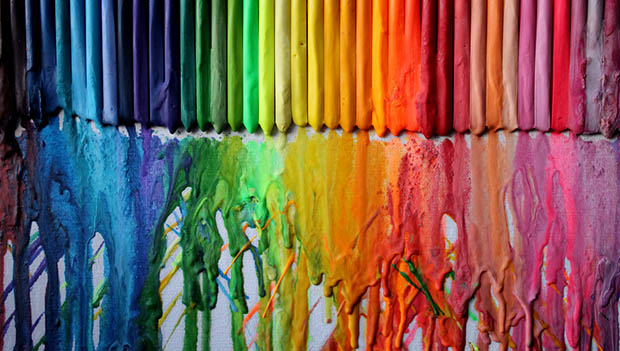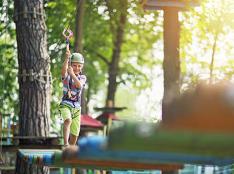
As the daytime hours shorten and the weather starts to cool, an increase in time spent indoors is likely to demand some creativity and resources. The back-to-school season might have you and your child longing for the adventures of summer, but a shared inquiry of how things work will surely help soften the transition from summer sunshine and relaxation to the cooler (and often busier) fall season.
Whether it be the seasonal fruits and vegetables or the natural variation in the color of the changing leaves, there is plenty for young, inquiring minds to engage with this season. Our advice: Take a brief walk outside to gather the resources you’ll need for a fun-filled, engaging afternoon for you and your child.
(STEAM stands for Science, Technology, Engineering, and Mathematics with the Arts!)
Fall Mobile
This project is the perfect combination between a hunter-gatherer’s and a physicist’s dream! From pinecones to leaves to household items—anything you can suspend from a string is relevant for this mobile project. For young children, enjoy the artistic process, make observations, identify the leaves and tree types and compare their shapes and sizes. For older children, take on the challenge of measurement and the question of “Why do heavier items hang closer to the center and lighter items hang farther away?”
Regardless of age, the art of “balance” is a good theme for all of us this time of year while enjoying the “fruits” of fall!
Autumn Leaf Sun Catcher
Fewer daytime hours doesn’t mean we have to enjoy the sunlight any less. There are many ways to both highlight and capture the sunlight that shines through your windows. From gathering leaves and arranging them carefully in contact paper to hang in your window, to melting beads into shapes using cookie cutters in the oven, learn more about ways you and your child can work together to capture the sun indoors this time of year.
Fall Salt Crystal Leaves
Perhaps the solution to all your fall free time is a little bit of solution chemistry! This project draws on the science of dissolving and either precipitating out (through super-saturating the solution) or waiting for the evaporation of the solvent (in this case, water) to form crystals.
The learn more link suggests salt, but if you try the same with sugar or borax, you will have an opportunity to compare crystal sizes and shapes. This art project can be turned into an experiment by asking questions like “How does the crystal type (salt/sugar/borax) affect crystal shape and size?” or “How does time affect the amount of crystals that form on a leaf in solution?” while enjoying the process of creating a beautiful fall art project with your child using chemistry!
SAFETY NOTE: While salt and sugar are consumables, borax is NOT (as it is a detergent). Children should be aided in understanding that no part of this art/experiment is consumable–no eating or drinking in this lab!
Learn More AboutSalt Crystal Leaves and Magic Crystal Snowflakes
Melting Crayons
Solids, liquids and gases–oh, my! No matter your child’s age, they will be wowed and engaged by the art they can create by adding heat to crayons on a canvas or piece of art paper. With the relatively low melting point of wax, a solid crayon can be turned into a liquid using mild temperature increases. All you need for this experiment is an art surface (canvas recommended), crayons and a hair dryer.
You can run an experiment while making art by asking questions about color mixing using different combinations of crayons or comparing results with different heat/intensity settings on the hair dryer. Challenge your child to predict outcomes as they lay out the crayons: “What do you think it will look like when you’re done?” Also, have them describe their steps and logic: “What will you do next?” to highlight the science behind this art project.
Food Dye and Flowers
Flowers aren’t reserved only for spring. Daisies are available well into autumn, and mums bloom from September through November. Both of these flowers work great for the famous “colorful carnations” experiment.
In this experiment, children are able to make observations that help them consider how plants consume water. By dying the water with various colors of food dye, you can change the color of both the stem and blossom on a white-flowering plant. This allows for not only an intriguing investigation, but also an eye-catching art piece atop any table in your house.
STEM idea: Leave a notebook with colored pencils by it for your child to record their observations over time, and use the colorful carnations link below to set up an experiment to compare results between the colored part of a stem and the “control” part of the stem that is not placed in colored water.
SAFETY NOTE: Please use adult supervision during all preparation steps requiring sharp objects.
Learn More AboutColored Flowers and Colorful Carnations
Pumpkin/Turkey Bowling
The physics behind hitting the pins—whether you’re bowling with a pumpkin or bowling to knock down a pumpkin—is absolutely worth considering, discussing or simply observing with your child. This is a great activity in which you can emphasize math and the number sets that add up to 10.
For example, each time have your child note how many pumpkins or turkeys they knocked down and how many they have left. You can also have them think scientifically by prompting them to share how and why they’re successful in each “bowl” by asking them to share what is and isn’t working in the process as you work together to revise, improve and succeed together! Either of the following links are a great spin on this active and engaging art, science and math project.
Learn More About Pumpkin Bowling and Turkey Bowling
Calling All Birds
From bird feeders to birdhouses to birdbaths, the following link includes a number of ways to attract these winged animals to your home using natural fall resources like twigs, gourds, pinecones and any recycled material you have around your house. These activities will entertain long past the building process as your child can channel their inner naturalist and take note of all the birds that visit your home for food, shelter or water.
It’s a great opportunity to discuss the necessities of life and other types of living things, as well as make observations of all the variations in size, shape and color of the bird species that visit your home. Again, leave a notebook near the window where you can see your homemade feeder, bath or house so your child can record their observations of these fall visitors. What a great discussion it will be to look back over these notes and pictures come winter!
READ THIS NEXT: How to Help Your Kids Thrive in STEM









Discuss This Article